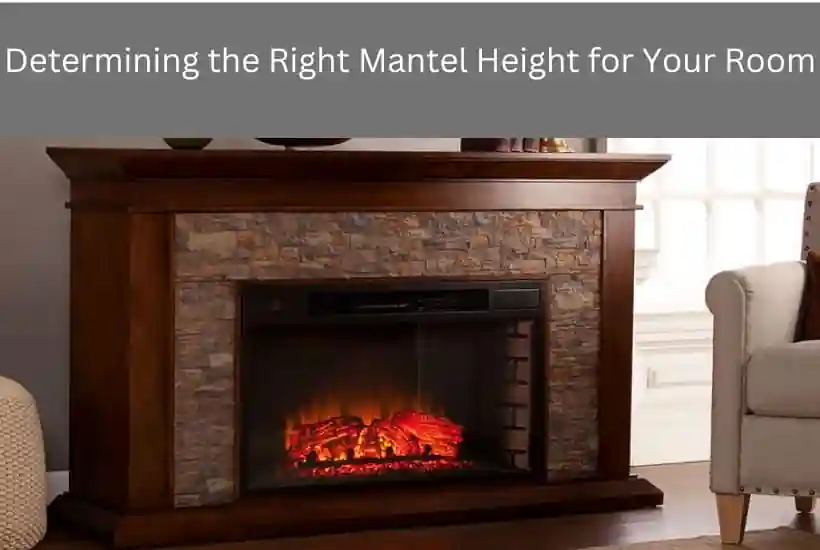A fireplace mantel height must be chosen carefully for both safety and aesthetic reasons. A room’s aesthetic appeal, use, and comfort can all be significantly impacted by the height at which a mantel is placed. The overall appearance of the fireplace is improved, and the room’s design is complemented when the mantel height is appropriate for the area. This resource offers information on common measures, design factors, and advice on how to choose the perfect mantel height for your fireplace.
1. Standard Mantel Height Measurements
Although there is no standard height for fireplace mantels, most guidelines offer a range that strikes a compromise between practicality, safety, and aesthetics. A summary of frequently used measurements is shown below:
- Average Wood-Burning Fireplace Height: The typical height for wood-burning fireplaces is between 54 and 60 inches from the floor to the mantel’s top. This height offers an unhindered view of the firebox and permits safe heat clearance.
- Gas fireplace height: Mantel heights of 48 to 54 inches are typical for gas fireplaces because they often require less clearance than wood-burning ones. However, for the particular model of your fireplace, always refer to the manufacturer’s instructions.
- Height Above the Firebox Opening: Typically, there is a 12- to 24-inch gap between the top of the firebox and the bottom of the mantel. In the case of wood-burning fireplaces, this clearance helps shield the mantel from heat damage.
- Think About Ceiling Height: Taller mantel heights can be accommodated by higher ceilings, while shorter mantel locations are better for lower ceilings to avoid a disproportionate appearance. A mantel height of roughly 54 inches from the floor is typical in rooms with 8-foot ceilings; mantel heights of 60 inches or more can be effective in spaces with 10-foot ceilings.
2. Determining the Right Mantel Height for Your Room

The design of the room, the height of the ceiling, and the kind of fireplace you have all influence the mantel height. The following factors will assist you in determining the ideal placement:
- Type of Fireplace and Clearances: The safety criteria and heat outputs of various fireplaces vary. More space is needed above the fireplace for wood-burning fireplaces in order to shield the mantel from heat damage. Generally speaking, gas and electric fireplaces offer greater flexibility.
- Height of the Ceiling and Room Proportion: A more balanced appearance can be achieved by placing mantels higher in rooms with higher ceilings. Lower mantels are necessary for lower ceilings to prevent a claustrophobic sensation.
- Room Focal Point: Since the fireplace frequently serves as the room’s main attraction, the mantel height should be chosen to highlight it without overpowering other features. The height should be changed if there is a television, a mirror, or artwork over the mantel.
- Comfort and Usability: Take into account how cozy the mantel will be to use. It could be difficult to reach decorations or other objects you might want to put there if it’s too high. In general, a lower mantel is simpler to adorn and gives off a cozier vibe.
3. Fireplace Mantel Height for TV Placement
Putting a TV above the fireplace is one of the most common design decisions. Nevertheless, there are certain difficulties when integrating a TV with a fireplace, particularly about height:
- TV viewing height ideal: The center of the TV screen should normally be at or below eye level for comfortable viewing. This indicates that the center of the TV is approximately 42 to 48 inches off the ground for the majority of seating configurations.
- Modifying fireplace Height for TV Positioning: If a TV is positioned above the fireplace, think about reducing the mantel height so that the TV can be viewed comfortably. By making this adjustment, you can avoid straining your neck from staring up at the screen. To keep the TV within a comfortable range in spaces with high ceilings, a lower mantel height can be required.
- Preventing Electronics from Heat Damage: Make sure the TV is elevated enough to prevent heat exposure because fireplace heat can harm electronics. If necessary, you can build a heat shield or use a mantel shelf to help divert heat away from the TV.
4. Mantel Height Based on Design Styles
The ideal mantel height can also be influenced by the room’s layout and the type of fireplace. The usual mantel heights for the following design trends are as follows:
- Conventional and Classic Mantels: Mantels in traditional forms are frequently higher, occasionally rising 60 inches or more off the ground. With crown molding or other elaborate details that go well with a slightly higher setting, these mantels are frequently more elaborate.
- Contemporary and Simple Mantels: The mantel height is frequently lowered in contemporary designs to produce a smooth, integrated appearance with the surrounding components. A height of about 48 inches off the ground may be ideal for this style.
- Farmhouse and Rustic Mantels: Rustic mantels are typically made of natural materials, such as stone or repurposed wood, and they function best at standard or somewhat lower heights. Lower placement, around 50 inches off the floor, enhances the warm, inviting appearance of these mantels, particularly in areas with exposed beams or other rustic accents.
- Industrial Mantels: Simple, robust materials like concrete or metal are frequently used in industrial styles. Depending on the architecture of the room, mantels in this style can vary in height, although they are typically lower to maintain a sleek, functional appearance.
5. Safety Considerations for Mantel Height

When placing mantels, safety is a major consideration, particularly for wood-burning fireplaces where the mantel may be subjected to high temperatures. Here are some things to remember:
- Removal of Heat Sources: For minimal clearances to flammable items, according to the manufacturer’s instructions. For gas and electric fireplaces, mantels made of wood or other combustible materials should be at least 12 inches above the fireplace entrance; for wood-burning fireplaces, they should be at least 20 inches.
- Verify Local Regulations and Building Codes: When installing a fireplace, make sure to check local building codes as they may have particular requirements for mantel height and clearance.
- Avoid Placing Heat-Sensitive Goods on Low Mantels: Refrain from placing heat-sensitive goods on lower mantels, particularly if the fireplace is wood-burning. Heat damage or a fire hazard could result from these things.
6. Customizing Mantel Height for Special Needs
Customization may be required in certain situations where a conventional mantel height is ineffective. Here’s how to modify a room according to its particular features:
- Small Rooms or Compact Spaces: Lower mantels (around 40 to 44 inches) might give the impression that a room is larger and more balanced in smaller spaces. Additionally, a lower placement allows the mantel to be decorated in small areas.
- Double-height ceilings and tall rooms: Raising the mantel height can help keep a room balanced in high-ceilinged spaces, such as double-height living rooms. In vast areas, the prominence of the fireplace is enhanced by taller mantels, which produce a strong vertical line.
- Multi-Function Living Areas: A lower mantel can help create a comfortable area around the fireplace without overly dividing the space into multi-functional spaces, like open-concept living and dining areas.
7. Tips for Decorating Around Your Chosen Mantel Height

Decorating your mantel can improve its aesthetic appeal and blend in with the room’s design after it is positioned at the ideal height.
- Layering Mirrors and Artwork: You can create height and intrigue by positioning a mirror or a work of art over the mantel. Larger pieces look best on higher mantels, while smaller, layered pieces look good on lower mantels.
- Holiday & Seasonal Décor: The perfect place for seasonal décor is a mantel. When putting ornaments such as candles, wreaths, or garlands, take into account their height, particularly if the mantel is high.
- Varying Object Heights: Combine objects of different heights to create a dynamic effect. Place smaller artifacts like ornamental books on lower mantels and taller things, such as candlesticks or vases, on higher mantels.
- Symmetry or Asymmetry: Asymmetrical mantel layouts give a stately appearance to conventional settings. Particularly on minimalist mantels, asymmetrical arrangements can offer a contemporary touch.
Conclusion
Achieving the ideal balance between comfort, safety, and beauty is key when selecting the height of a fireplace mantel. Standard heights are a nice place to start, but the choice will ultimately depend on things like room design, fireplace type, and ceiling height. Careful planning and attention to safety clearances will guarantee that your mantel enriches the space while maintaining its safety and comfort, whether your goal is a traditional design with a taller fireplace or a modern style with a lower mantel. Your mantel can become a stunning focal point that gives any room coziness, personality, and flair with the correct arrangement and careful embellishment.







